
Am Fam Physician. 2013;87(1):48-54
Related letter: Chagas Disease Is a Consideration in Latino Patients
Author disclosure: No relevant financial affiliations to disclose.
Latinos comprise nearly 16 percent of the U.S. population, and this proportion is anticipated to increase to 30 percent by 2050. Latinos are a diverse ethnic group that includes many different cultures, races, and nationalities. Barriers to care have resulted in striking disparities in quality of health care for these patients. These barriers include language, lack of insurance, different cultural beliefs, and in some cases, illegal immigration status, mistrust, and illiteracy. The National Standards for Culturally and Linguistically Appropriate Services address these concerns with recommendations for culturally competent care, language services, and organizational support. Latinos have disproportionately higher rates of obesity and diabetes mellitus. Other health problems include stress, neurocysticercosis, and tuberculosis. It is important to explore the use of alternative therapies and belief in traditional folk illnesses, recognizing that health beliefs are dependent on education, socioeconomic status, and degree of acculturation. Many—but not all—folk and herbal treatments can be safely accommodated with conventional therapy. Physicians must be sensitive to Latino cultural values of simpatia (kindness), personalismo (relationship), respeto (respect), and modestia (modesty). The LEARN technique can facilitate cross-cultural interviews. Some cultural barriers may be overcome by using the “teach back” technique to ensure that directions are correctly understood and by creating a welcoming health care environment for Latino patients.
The ethnic terms Latino or Hispanic refer to a diverse population of Latin American descent that includes many nationalities and races. Latino refers to a person of Cuban, Mexican, Puerto Rican, South or Central American, or other Spanish culture or origin, regardless of race.1 Latinos comprised nearly 16 percent of the U.S. population in 2009, making them the largest minority group.1 By 2050, it is projected that they will comprise up to 30 percent of the U.S. population.2 The three largest subgroups include Mexican Americans (about 65 percent), mostly settled in the Southwest, Puerto Ricans (9.1 percent) in the urban Northeast, and Cuban Americans (3.5 percent) in Florida.3 However, these demographics are rapidly shifting as Latino populations are increasingly integrated into suburban and rural communities throughout America. About 23 percent of Latinos in the United States live in poverty.2
There is ample evidence that Latinos, especially those of Mexican and Central American origin, face significant obstacles to obtaining health care, especially language barriers.4 Many hospitals and offices lack trained interpreters and rely on ad hoc interpretation by bilingual staff or even the children of patients. Lack of third party reimbursement for professional interpreter services exacerbates this problem. Adding to the language barrier is the pitfall of false fluency, when physicians mistake the meaning of a Spanish word because of unfamiliarity with cultural or linguistic subtleties.4 Another barrier is inability to afford health insurance; nearly one-third of Latinos (30.7 percent) lack coverage.5 Yet another barrier stems from cultural mistrust coupled with a predisposition to seek alternative care first, thus delaying conventional treatment. Many Latinos are accustomed to self-treating because most pharmaceuticals are available without prescription in their home countries. Recent immigrants may face additional obstacles to care, including illegal immigration status (fears of deportation), illiteracy, and a radically different set of health beliefs.
A consequence of these problems is a marked disparity in the quality of care that Latino patients receive. In a 2002 report from the Institute of Medicine, more than 175 studies were cited to document this disparity.6 In an attempt to address this problem, the National Standards for Culturally and Linguistically Appropriate Services (CLAS) were released in 2001 by the Office of Minority Health of the U.S. Department of Health and Human Services.7 Fourteen guidelines were published, which were organized around three main themes: culturally competent care, language access services, and organizational supports. Culturally competent care necessitates cross-cultural training, which is increasingly included in medical education, but with the realization that cultural competency is a lifelong learning process rather than an end in itself.8
| Clinical recommendation | Evidence rating | References |
|---|---|---|
| Instituting more culturally competent care is likely to improve treatment adherence and health outcomes. | C | 7, 8 |
| Interferon gamma–release screening tests are preferable to tuberculin skin testing in immigrants who have received the bacille Calmette-Guérin vaccine. | C | 13 |
| Most, although not all, alternative therapies in the Latino community are not harmful and may be combined with conventional care. | C | 19–21 |
| The “teach back” technique should be incorporated into the cross-cultural patient encounter to ensure patient understanding of discharge instructions. | C | 31 |
| Patient activation will help motivate the patient to become involved in his or her own care. | C | 32 |
Health Issues
SPECIAL MEDICAL CONCERNS
Latinos have disproportionately higher rates of obesity and diabetes mellitus (Table 1).9–14 Approximately 43 percent of Mexican Americans older than 20 years are obese, compared with 33 percent of the non-Latino white population.12 Diabetes and hypertension are closely linked with obesity; 11.8 percent of Latinos older than 20 years have type 2 diabetes (13.3 percent of Mexican Americans), making it the foremost health issue in this population.14 A higher-calorie diet, a more sedentary lifestyle, and genetic factors contribute to this problem. Because of less access to health care, Latinos with diabetes are often diagnosed later and have a greater risk of complications.15,16 Despite these unfavorable health and socioeconomic statistics, overall mortality is lower than would be expected—an anomaly termed the Hispanic paradox.17 Latinos live an average of 2.5 years longer than non-Latino whites (to 80 years, seven months of age) and 7.7 years longer than non-Latino blacks.1 It is not known what protective factors exist, but immigrant hardiness, social integration, and diet may have a role.1 Raising awareness about the consequences of obesity is necessary in Latino communities, especially because being somewhat overweight (gordito) can be considered healthy. Mexican Americans are much less likely to be treated for hypertension than non-Latino whites (35 versus 49 percent).11 Targeted public health campaigns are needed for hypertension, diabetes prevention, and weight control.
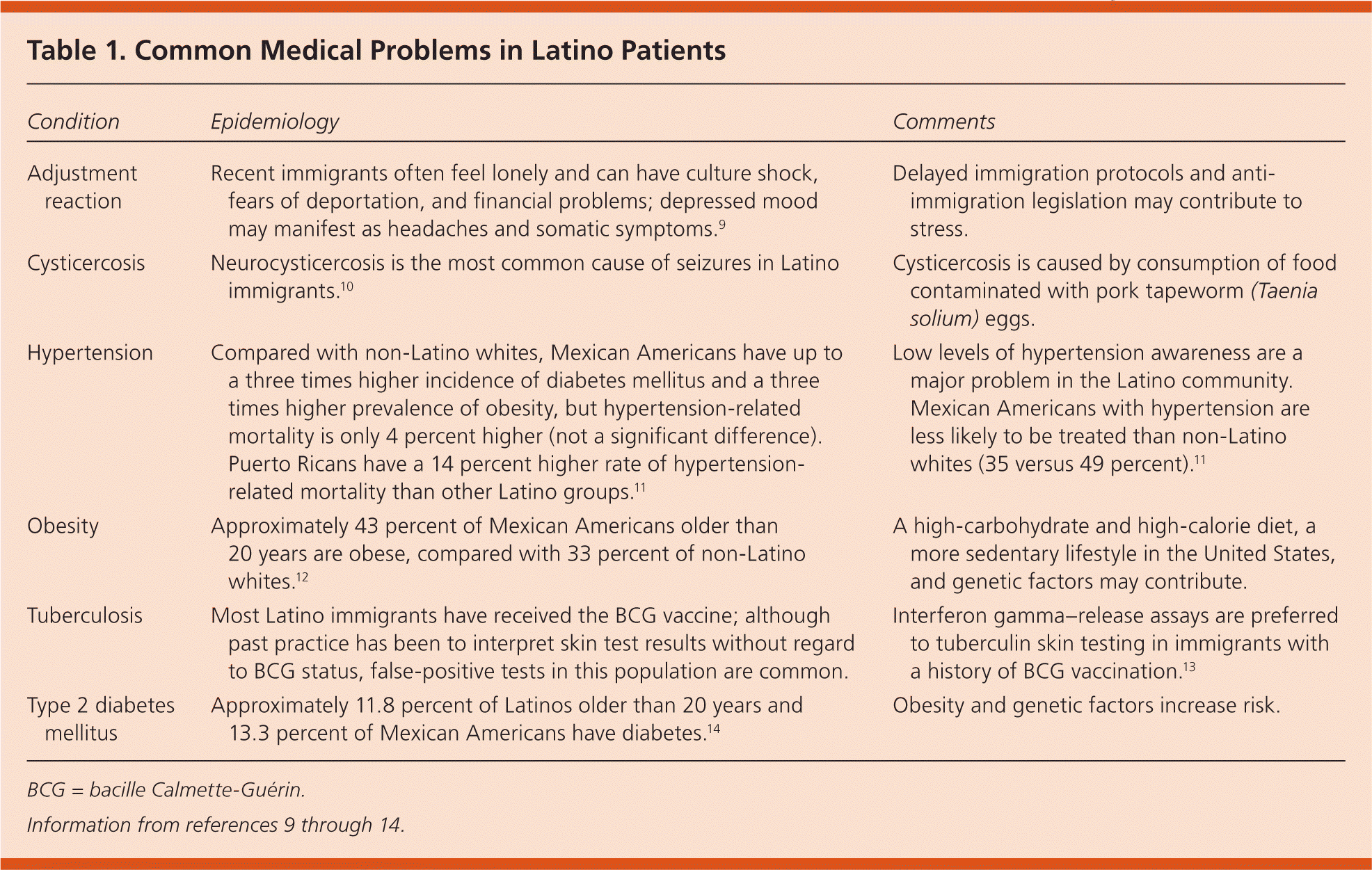
| Condition | Epidemiology | Comments |
|---|---|---|
| Adjustment reaction | Recent immigrants often feel lonely and can have culture shock, fears of deportation, and financial problems; depressed mood may manifest as headaches and somatic symptoms.9 | Delayed immigration protocols and anti-immigration legislation may contribute to stress. |
| Cysticercosis | Neurocysticercosis is the most common cause of seizures in Latino immigrants.10 | Cysticercosis is caused by consumption of contaminated with pork tapeworm (Taenia solium) eggs. |
| Hypertension | Compared with non-Latino whites, Mexican Americans have up to a three times higher incidence of diabetes mellitus and a three times higher prevalence of obesity, but hypertension-related mortality is only 4 percent higher (not a significant difference). Puerto Ricans have a 14 percent higher rate of hypertension-related mortality than other Latino groups.11 | Low levels of hypertension awareness are a major problem in the Latino community. Mexican Americans with hypertension are less likely to be treated than non-Latino whites (35 versus 49 percent).11 |
| Obesity | Approximately 43 percent of Mexican Americans older than 20 years are obese, compared with 33 percent of non-Latino whites.12 | A high-carbohydrate and high-calorie diet, a more sedentary lifestyle in the United States, and genetic factors may contribute. |
| Tuberculosis | Most Latino immigrants have received the BCG vaccine; although past practice has been to interpret skin test results without regard to BCG status, false-positive tests in this population are common. | Interferon gamma–release assays are preferred to tuberculin skin testing in immigrants with a history of BCG vaccination.13 |
| Type 2 diabetes mellitus | Approximately 11.8 percent of Latinos older than 20 years and 13.3 percent of Mexican Americans have diabetes.14 | Obesity and genetic factors increase risk. |
Many Latino immigrants experience tremendous stress once they are in the United States. Emotional distress often presents with headaches (dolor de cabeza) or other physical symptoms instead of depressed mood.9 Consequently, a high index of suspicion is needed to recognize adjustment reactions or depression. Neurocysticercosis, a leading cause of seizures in Mexico, and pulmonary tuberculosis are more common in Latino immigrants.10 Interferon gamma–release assay blood testing for tuberculosis is now preferred over tuberculin skin testing in immigrants with a history of bacille Calmette-Guérin vaccination because of a high rate of false-positive results with skin testing (although skin testing is still recommended for children younger than five years).13 Publicized fears of contagion from illegal immigration may be overblown. Despite a lack of U.S. studies, a Norwegian study found that although immigrants from tuberculosis-endemic regions did bring more strains of tuberculosis with them, they did not significantly contribute to the spread of tuberculosis within the resident population.18
HEALTH CARE BELIEFS AND FOLK ILLNESSES
Non-Latino physicians may be perplexed by references to folk healing and illness in Latino patients. Latino healing traditions include curanderismo in Mexico and much of Latin America, Santeria in Brazil and Cuba, and espiritismo in Puerto Rico.19 Curanderos, traditional healers, distinguish between “hot” and “cold” illnesses (Table 220 ) and occasionally between natural and unnatural (sorcery-related) diseases.19,20 Patients may seek out the care of brujos or brujas (wizards or witches) for the latter conditions. Other healing specialties include yerberas (herbalists), hueseros (bone setters), parteras (midwives), and sobradores (similar to physical therapists).21
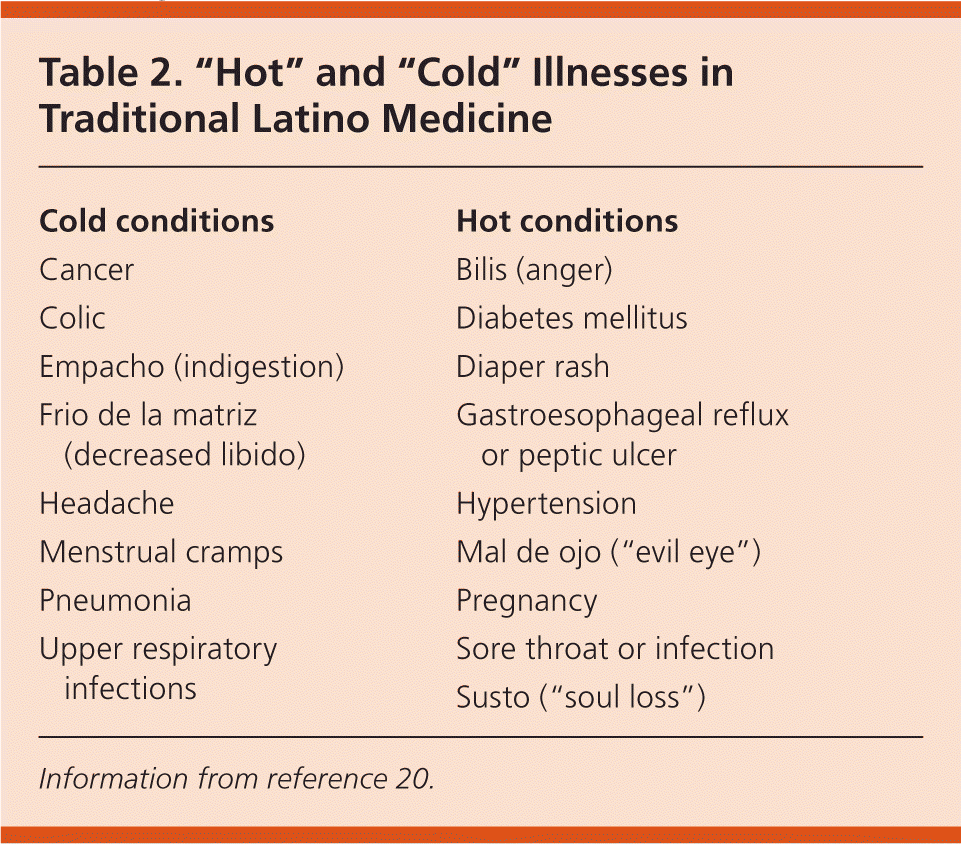
| Cold conditions |
| Cancer |
| Colic |
| Empacho (indigestion) |
| Frio de la matriz (decreased libido) |
| Headache |
| Menstrual cramps |
| Pneumonia |
| Upper respiratory infections |
| Hot conditions |
| Bilis (anger) |
| Diabetes mellitus |
| Diaper rash |
| Gastroesophageal reflux or peptic ulcer |
| Hypertension |
| Mal de ojo (“evil eye”) |
| Pregnancy |
| Sore throat or infection |
| Susto (“soul loss”) |
Symptoms are often interpreted differently based on cultural presuppositions. Posttraumatic shock or anxiety may be attributed to susto (“soul loss”) rather than posttraumatic stress disorder. Abdominal pain may be attributed to empacho, or food stuck in the intestine. A child's failure to thrive may be attributed to mal de ojo (“evil eye”), a hex conveyed by an envious glance. Table 3 lists some common Latino folk illnesses, their symptoms, and treatment.19 Therapies for these conditions may seem odd, but most are harmless, with a few exceptions. Azarcon and greta (lead salts) and azogue (mercury) compounds, which are sometimes given for teething or empacho, are contraindicated.22 Some injuries have occurred with curandero treatment of caida de la mollera (“fallen fontanel”). However, it may be more likely to mistakenly suspect child abuse than to actually encounter it in patients who use traditional treatments.23
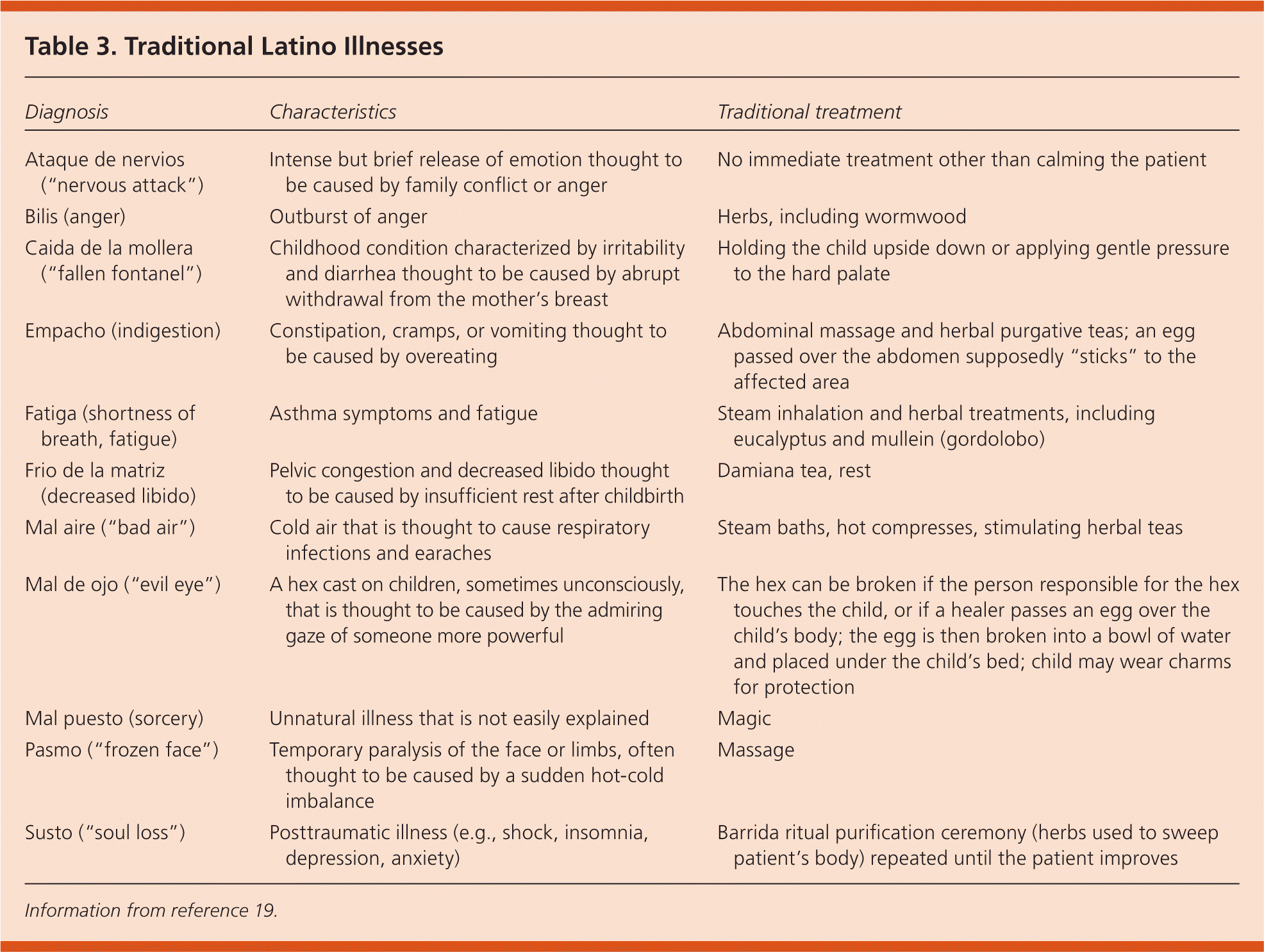
| Diagnosis | Characteristics | Traditional treatment |
|---|---|---|
| Ataque de nervios (“nervous attack”) | Intense but brief release of emotion thought to be caused by family conflict or anger | No immediate treatment other than calming the patient |
| Bilis (anger) | Outburst of anger | Herbs, including wormwood |
| Caida de la mollera (“fallen fontanel”) | Childhood condition characterized by irritability and diarrhea thought to be caused by abrupt withdrawal from the mother's breast | Holding the child upside down or applying gentle pressure to the hard palate |
| Empacho (indigestion) | Constipation, cramps, or vomiting thought to be caused by overeating | Abdominal massage and herbal purgative teas; an egg passed over the abdomen supposedly “sticks” to the affected area |
| Fatiga (shortness of breath, fatigue) | Asthma symptoms and fatigue | Steam inhalation and herbal treatments, including eucalyptus and mullein (gordolobo) |
| Frio de la matriz (decreased libido) | Pelvic congestion and decreased libido thought to be caused by insufficient rest after childbirth | Damiana tea, rest |
| Mal aire (“bad air”) | Cold air that is thought to cause respiratory infections and earaches | Steam baths, hot compresses, stimulating herbal teas |
| Mal de ojo (“evil eye”) | A hex cast on children, sometimes unconsciously, that is thought to be caused by the admiring gaze of someone more powerful | The hex can be broken if the person responsible for the hex touches the child, or if a healer passes an egg over the child's body; the egg is then broken into a bowl of water and placed under the child's bed; child may wear charms for protection |
| Mal puesto (sorcery) | Unnatural illness that is not easily explained | Magic |
| Pasmo (“frozen face”) | Temporary paralysis of the face or limbs, often thought to be caused by a sudden hot-cold imbalance | Massage |
| Susto (“soul loss”) | Posttraumatic illness (e.g., shock, insomnia, depression, anxiety) | Barrida ritual purification ceremony (herbs used to sweep patient's body) repeated until the patient improves |
Herbal therapies play a major role in Latino folk medicine, so knowing the Spanish names of common herbs can be helpful (eTable A). A large selection of herbal teas are available from botanicas or yerberas in most Latino neighborhoods. Herbs often have hot or cold properties; hot herbs are used to treat cold conditions, and vice versa. A mother might use cooling herbs to treat diaper rash, a hot condition. She might also stop giving her infant vitamins, because they are a hot therapy.24 It is often possible to safely accommodate conventional and alternative treatments (in reasonable doses) if potential conflicts or interactions are identified in advance. Web-based resources are available to assist physicians in understanding Latino health beliefs (Table 4).
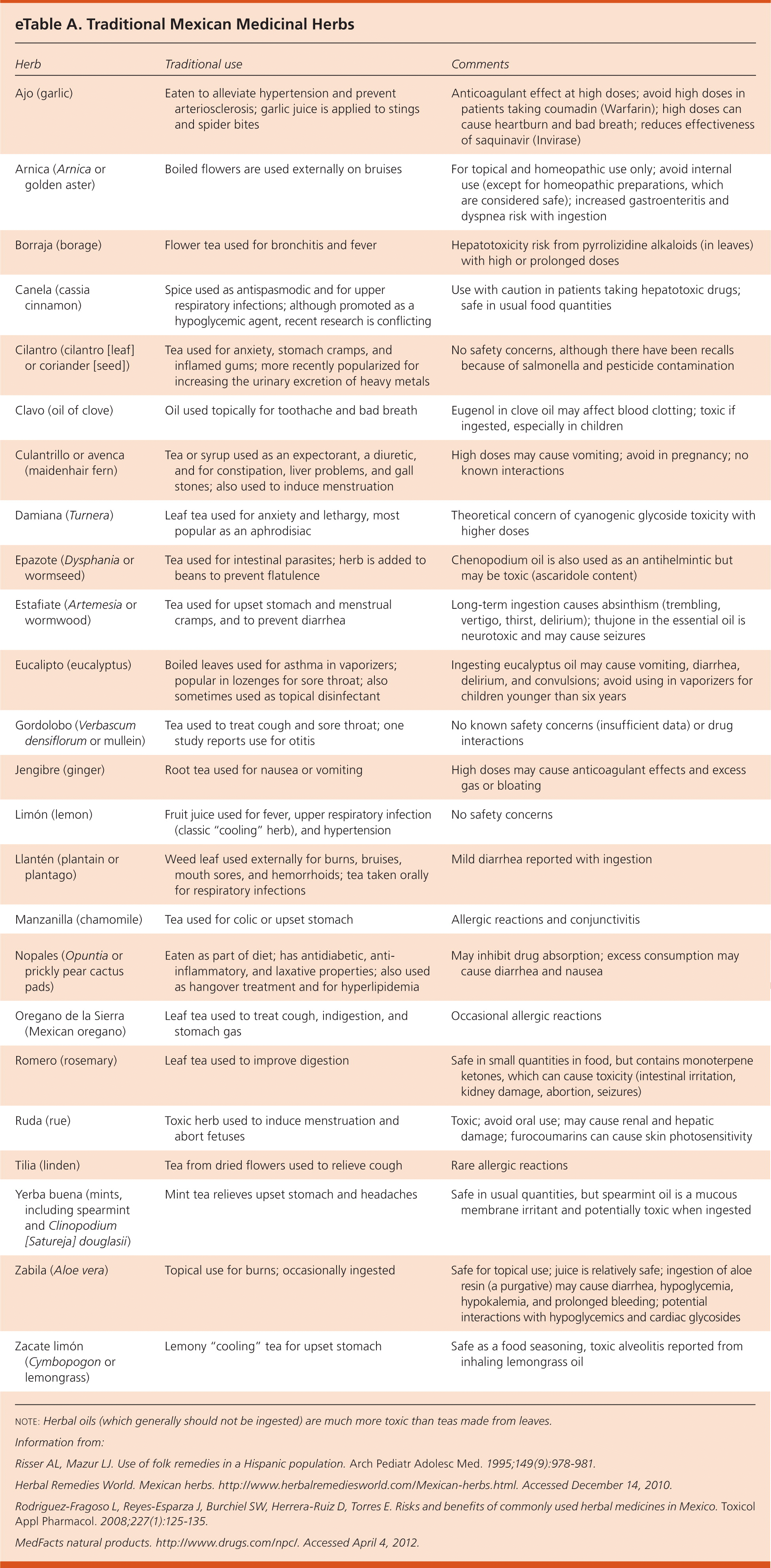
| Herb | Traditional use | Comments |
|---|---|---|
| Ajo (garlic) | Eaten to alleviate hypertension and prevent arteriosclerosis; garlic juice is applied to stings and spider bites | Anticoagulant effect at high doses; avoid high doses in patients taking coumadin (Warfarin); high doses can cause heartburn and bad breath; reduces effectiveness of saquinavir (Invirase) |
| Arnica (Arnica or golden aster) | Boiled flowers are used externally on bruises | For topical and homeopathic use only; avoid internal use (except for homeopathic preparations, which are considered safe); increased gastroenteritis and dyspnea risk with ingestion |
| Borraja (borage) | Flower tea used for bronchitis and fever | Hepatotoxicity risk from pyrrolizidine alkaloids (in leaves) with high or prolonged doses |
| Canela (cassia cinnamon) | Spice used as antispasmodic and for upper respiratory infections; although promoted as a hypoglycemic agent, recent research is conflicting | Use with caution in patients taking hepatotoxic drugs; safe in usual food quantities |
| Cilantro (cilantro [leaf] or coriander [seed]) | Tea used for anxiety, stomach cramps, and inflamed gums; more recently popularized for increasing the urinary excretion of heavy metals | No safety concerns, although there have been recalls because of salmonella and pesticide contamination |
| Clavo (oil of clove) | Oil used topically for toothache and bad breath | Eugenol in clove oil may affect blood clotting; toxic if ingested, especially in children |
| Culantrillo or avenca (maidenhair fern) | Tea or syrup used as an expectorant, a diuretic, and for constipation, liver problems, and gall stones; also used to induce menstruation | High doses may cause vomiting; avoid in pregnancy; no known interactions |
| Damiana (Turnera) | Leaf tea used for anxiety and lethargy, most popular as an aphrodisiac | Theoretical concern of cyanogenic glycoside toxicity with higher doses |
| Epazote (Dysphania or wormseed) | Tea used for intestinal parasites; herb is added to beans to prevent flatulence | Chenopodium oil is also used as an antihelmintic but may be toxic (ascaridole content) |
| Estafiate (Artemesia or wormwood) | Tea used for upset stomach and menstrual cramps, and to prevent diarrhea | Long-term ingestion causes absinthism (trembling, vertigo, thirst, delirium); thujone in the essential oil is neurotoxic and may cause seizures |
| Eucalipto (eucalyptus) | Boiled leaves used for asthma in vaporizers; popular in lozenges for sore throat; also sometimes used as topical disinfectant | Ingesting eucalyptus oil may cause vomiting, diarrhea, delirium, and convulsions; avoid using in vaporizers for children younger than six years |
| Gordolobo (Verbascum densiflorum or mullein) | Tea used to treat cough and sore throat; one study reports use for otitis | No known safety concerns (insufficient data) or drug interactions |
| Jengibre (ginger) | Root tea used for nausea or vomiting | High doses may cause anticoagulant effects and excess gas or bloating |
| Limón (lemon) | Fruit juice used for fever, upper respiratory infection (classic “cooling” herb), and hypertension | No safety concerns |
| Llantén (plantain or plantago) | Weed leaf used externally for burns, bruises, mouth sores, and hemorrhoids; tea taken orally for respiratory infections | Mild diarrhea reported with ingestion |
| Manzanilla (chamomile) | Tea used for colic or upset stomach | Allergic reactions and conjunctivitis |
| Nopales (Opuntia or prickly pear cactus pads) | Eaten as part of diet; has antidiabetic, anti-inflammatory, and laxative properties; also used as hangover treatment and for hyperlipidemia | May inhibit drug absorption; excess consumption may cause diarrhea and nausea |
| Oregano de la Sierra | Leaf tea used to treat cough, indigestion, and | Occasional allergic reactions |
| (Mexican oregano) | stomach gas | |
| Romero (rosemary) | Leaf tea used to improve digestion | Safe in small quantities in food, but contains monoterpene ketones, which can cause toxicity (intestinal irritation, kidney damage, abortion, seizures) |
| Ruda (rue) | Toxic herb used to induce menstruation and abort fetuses | Toxic; avoid oral use; may cause renal and hepatic damage; furocoumarins can cause skin photosensitivity |
| Tilia (linden) | Tea from dried flowers used to relieve cough | Rare allergic reactions |
| Yerba buena (mints, including spearmint and Clinopodium [Satureja] douglasii) | Mint tea relieves upset stomach and headaches | Safe in usual quantities, but spearmint oil is a mucous membrane irritant and potentially toxic when ingested |
| Zabila (Aloe vera) | Topical use for burns; occasionally ingested | Safe for topical use; juice is relatively safe; ingestion of aloe resin (a purgative) may cause diarrhea, hypoglycemia, hypokalemia, and prolonged bleeding; potential interactions with hypoglycemics and cardiac glycosides |
| Zacate limón (Cymbopogon or lemongrass) | Lemony “cooling” tea for upset stomach | Safe as a food seasoning, toxic alveolitis reported from inhaling lemongrass oil |
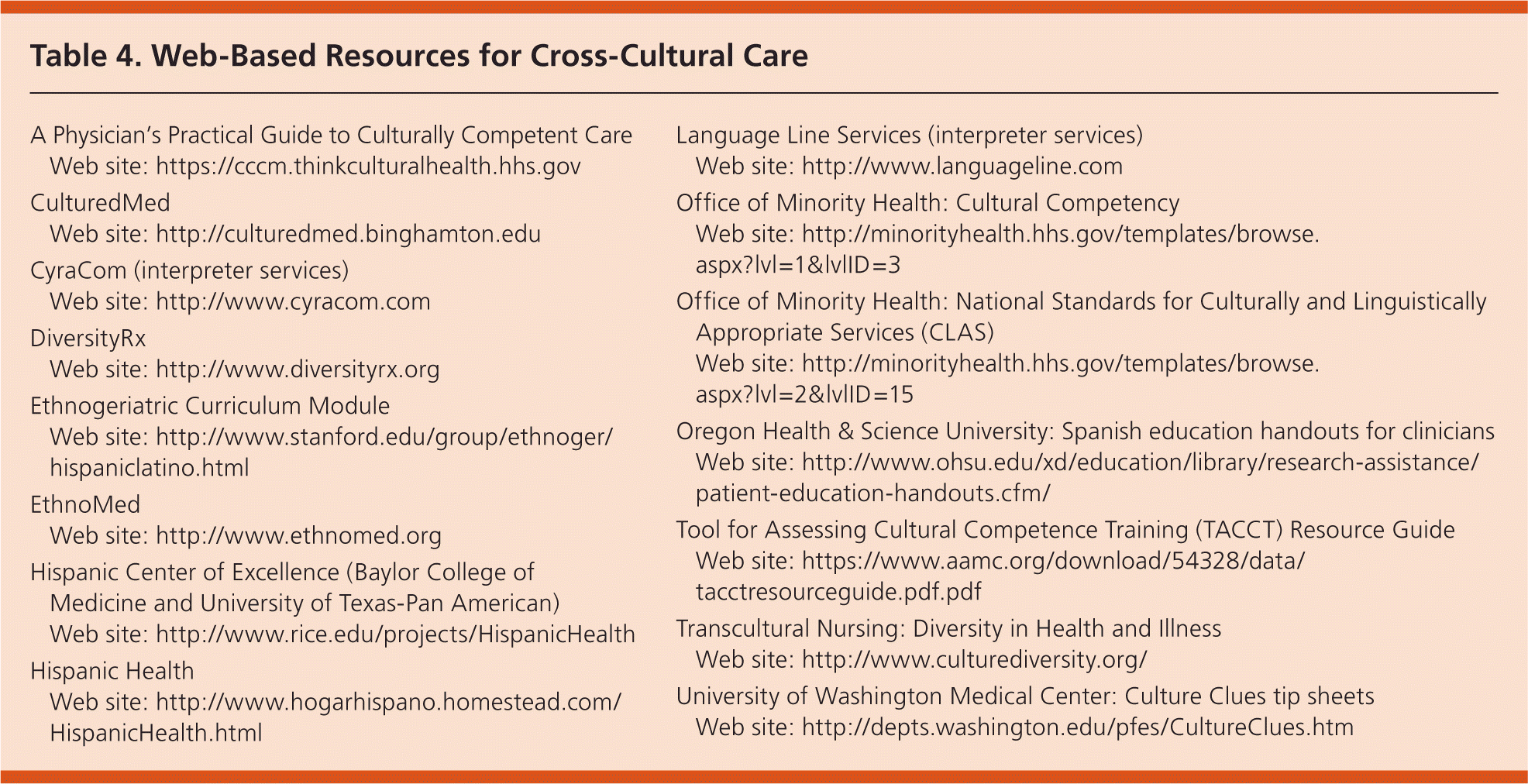
| A Physician's Practical Guide to Culturally Competent Care | |
| Web site: https://cccm.thinkculturalhealth.hhs.gov | |
| CulturedMed | |
| Web site: http://culturedmed.binghamton.edu | |
| CyraCom (interpreter services) | |
| Web site: http://www.cyracom.com | |
| DiversityRx | |
| Web site: http://www.diversityrx.org | |
| Ethnogeriatric Curriculum Module | |
| Web site: http://www.stanford.edu/group/ethnoger/hispaniclatino.html | |
| EthnoMed | |
| Web site: http://www.ethnomed.org | |
| Hispanic Center of Excellence (Baylor College of Medicine and University of Texas-Pan American) | |
| Web site: http://www.rice.edu/projects/HispanicHealth | |
| Hispanic Health | |
| Web site: http://www.hogarhispano.homestead.com/HispanicHealth.html | |
| Language Line Services (interpreter services) | |
| Web site: http://www.languageline.com | |
| Office of Minority Health: Cultural Competency | |
| Web site: http://minorityhealth.hhs.gov/templates/browse.aspx?lvl=1&lvlID=3 | |
| Office of Minority Health: National Standards for Culturally and Linguistically Appropriate Services (CLAS) | |
| Web site: http://minorityhealth.hhs.gov/ | |
| Oregon Health & Science University: Spanish education handouts for clinicians | |
| Web site: http://www.ohsu.edu/xd/education/library/research-assistance/patient-education-handouts.cfm/ | |
| Tool for Assessing Cultural Competence Training (TACCT) Resource Guide | |
| Web site: https://www.aamc.org/download/54328/data/tacctresourceguide.pdf.pdf | |
| Transcultural Nursing: Diversity in Health and Illness | |
| Web site: http://www.culturediversity.org/ | |
| University of Washington Medical Center: Culture Clues tip sheets | |
| Web site: http://depts.washington.edu/pfes/CultureClues.htm | |
Patients should be asked if they use alternative therapies, because it is not likely that such information will be volunteered. Latinos' belief in alternative treatment is affected by many factors, including education, socioeconomic class, and time spent in the United States (acculturation). First-generation immigrants are likely to seek out curanderos, whereas their children may scoff at the idea. Physicians cannot assume that all Latinos share these beliefs; many do not. America is rapidly changing as a “cultural collision” between Latino and white culture transforms lives on both sides of the border. Exposure to U.S. media is changing traditional Latino perceptions of health, diet, and body image, even as non-Latino Americans are influenced by Mexican cuisine and culture.
Approaches to Care
CULTURAL VALUES
Latino culture has several normative values that must be recognized in clinical settings. These include simpatía (kindness), personalismo (friendliness), and respeto (respect).25 Simpatía emphasizes politeness and conflict avoidance. Personalismo, a personal connection, can be achieved by asking about the patient and his or her family. Because people stand closer to each other in most Latino cultures, physical proximity is also perceived as being more personable. Respeto implies attentive concern for the patient and respect of his or her personhood and age, especially if the patient is older. Older patients should be addressed as señor or señora rather than by their first names. Using don or doña with the given or full name indicates even greater respect for older patients.
Addressing patients properly can be another challenge. Double or hyphenated Latino surnames may seem complicated, with the father's name preceding the mother's. Additionally, when a woman gets married, her husband's name may be appended to her father's name. After immigration, some Latios adopt American naming conventions, but others do not. When in doubt, the best policy is to ask the patient how he or she would like to be addressed.26
The cultural value of modestia (modesty), which is related to respect, is often neglected.27 Latinos may be conservative in this area, and physical exposure should be negotiated as the examination warrants. A chaperone is often appreciated if a same-sex physician is not available. Although patients of all cultural backgrounds warrant kindness, a personal connection, and respect, the consequences of omitting these traditional values may be more problematic with Latinos.
CROSS-CULTURAL INTERVIEW
Cross-cultural interviewing can be facilitated by following specific guidelines, and several mnemonics have been developed for use by physicians. In the LEARN model, which is illustrated in the Case Study below,28,29 the physician should first sympathetically listen to the patient's perception of the problem, explain his or her perception of the problem to the patient, acknowledge and discuss any differences and similarities between the two views, recommend a treatment plan, and negotiate agreement.30 Use of the LEARN technique identifies and helps resolve any cultural differences that may arise.
| Maria is a 54-year-old Mexican immigrant with type 2 diabetes mellitus, hypertension, and obesity. Her visits to your clinic have been challenging because of her limited English proficiency, late arrivals, and nonadherence to several medications. She agrees to start taking medications, but does not refill her prescriptions or lose weight. | |
| During Maria's next visit, you arrange for a telephone interpreter, which enables you to take a brief social history. She has three grown children: two still live in Mexico, and the third lives in a distant U.S. city. Her husband died in an industrial accident four years ago, and she is still grieving. She asks about your family, and hesitantly, through the interpreter, you share a bit about your own children. Her face lights up when you share this. | |
| Using the LEARN model, you listen to her story about her poor control of diabetes and frustration with her diet. She says that she does not feel better when taking the medicine, and says the diet you prescribed does not include tortillas or any of the foods she likes. She says that since her husband died, she has lost interest in what might happen to her in the future. You explain why these interventions are necessary, but acknowledge her frustration and agree to revise her diet. You recommend a compromise treatment plan for her diabetes and grief. After some negotiation, she agrees to see a dietitian and a bilingual counselor, and agrees to take just two medications, metformin (Glucophage) and lisinopril (Zestril), although she understands that they will not make her feel better right away. You use “teach back” to ensure that Maria understands your directions, and you provide her with Spanish-language handouts about the benefits of controlling her diabetes and hypertension. You then schedule a return visit, during which an interpreter will be available. | |
| You call the dietitian to alert him to this patient's cultural concerns. Maria needs to eat fruit; she should also consume more fiber to counteract her high-carbohydrate diet. One suggestion she readily agrees to is to include nopales (prickly pear cactus pads), a favorite from her childhood in Mexico. This traditional food is high in fiber and pectin and lowers lipid levels by binding bile acids; when eaten with other foods, it reduces the glycemic index of the meal by 50 percent.28 Because nopales may inhibit the absorption of drugs as well as glucose,29 Maria was told not to take her medications within a few hours of eating it. Other vegetables and fruits she likes are added to replace some other carbohydrates. The counselor helps her with her grief, and gets her involved in an exercise and weight loss group at her church. | |
| Your efforts pay off at the next visit, when Maria expresses much more interest in controlling her diabetes and shows personal warmth that was missing from earlier encounters. She has lost 10 lb (4.5 kg), and for the first time has acceptable blood pressure and fasting glucose levels. It took extra time in relationship-building (personalismo), a team approach, an interpreter, negotiation, and a bit of research to make it all happen. |
TEACH BACK AND PATIENT ACTIVATION
Conveying medical instructions to patients with limited English skills can be frustrating. For literate patients, it may be helpful to write things down, even if this must be done in English rather than Spanish. These instructions can be studied by the patient or translated when time permits. Spanish language handouts are a better option. However, the most useful technique is “teach back” or “show me”: having patients repeat their care instructions until they do it correctly. The extra time necessary for this technique is justified by the prospect of much better understanding and adherence.31
Patients should be actively involved in their care rather than passively acquiescing to instructions. Such “patient activation” or motivation for change is more challenging in foreign-born Latinos, but may be achieved through active dialogue and discussion.32 Hopeful involvement in the care plan should replace fatalism or resignation.
A CARING ENVIRONMENT
Medical practices and hospitals should strive to create an environment that is warm and welcoming to Latino patients. Bilingual posters and medical literature are an important starting point. Spanish language handouts are available from several Internet sources.33 Recruiting Latino physicians and staff, and recognizing Latino holidays at the office (e.g., Cinco de Mayo), will open many doors to the Latino community.34 Office staff, as well as physicians, should be instructed in basic cultural sensitivity (Table 5).34,35 Hospitals can include culturally appropriate foods in their menus.
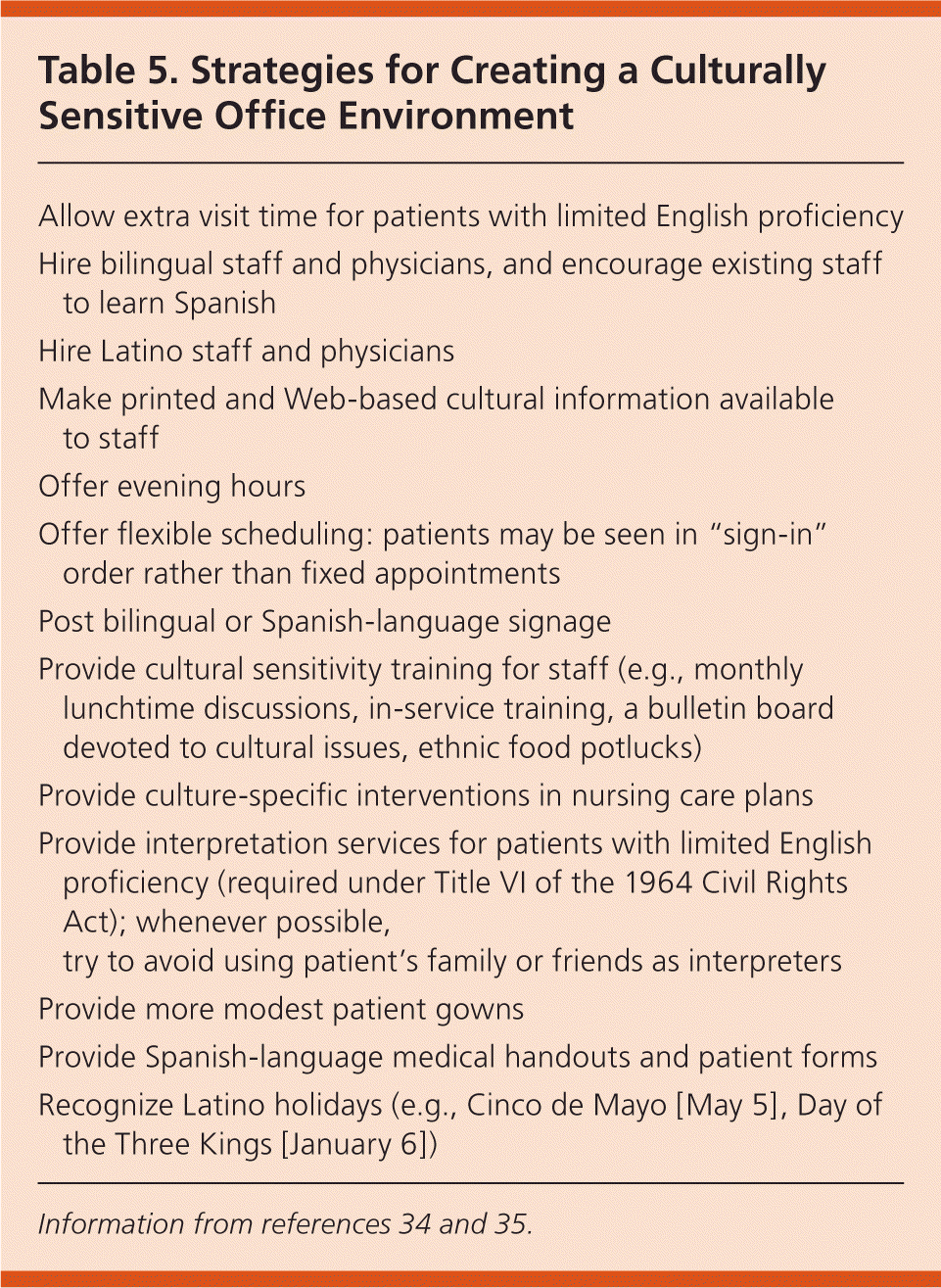
| Allow extra visit time for patients with limited English proficiency |
| Hire bilingual staff and physicians, and encourage existing staff to learn Spanish |
| Hire Latino staff and physicians |
| Make printed and Web-based cultural information available to staff |
| Offer evening hours |
| Offer flexible scheduling: patients may be seen in “sign-in” order rather than fixed appointments |
| Post bilingual or Spanish-language signage |
| Provide cultural sensitivity training for staff (e.g., monthly lunchtime discussions, in-service training, a bulletin board devoted to cultural issues, ethnic food potlucks) |
| Provide culture-specific interventions in nursing care plans |
| Provide interpretation services for patients with limited English |
| proficiency (required under Title VI of the 1964 Civil Rights Act); whenever possible, try to avoid using patient's family or friends as interpreters |
| Provide more modest patient gowns |
| Provide Spanish-language medical handouts and patient forms |
| Recognize Latino holidays (e.g., Cinco de Mayo [May 5], Day of the Three Kings [January 6]) |
Developing cultural sensitivity to Latino patients entails recognizing and appreciating their diversity. As with any patient, Latinos should be treated as individuals first, while exploring possible cultural distinctions. Bridging such cultural gaps, wide or narrow, will result in better physician-patient relationships and more effective care.
